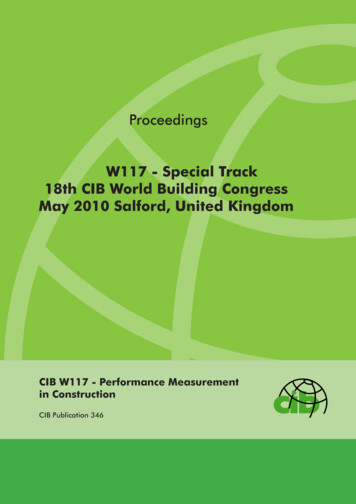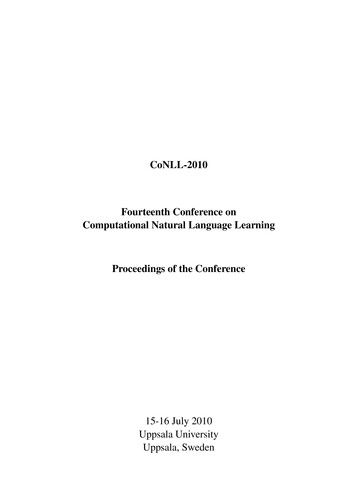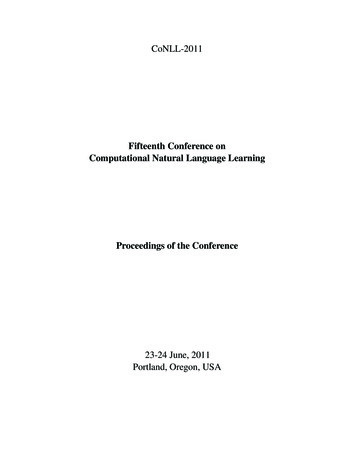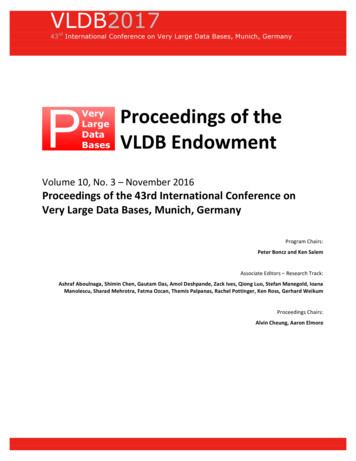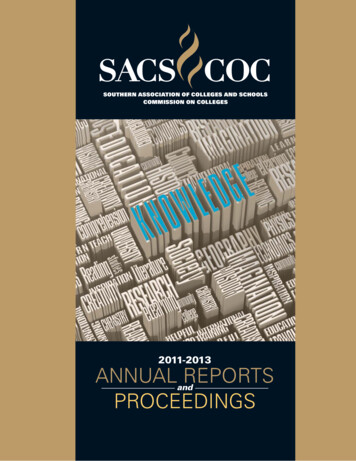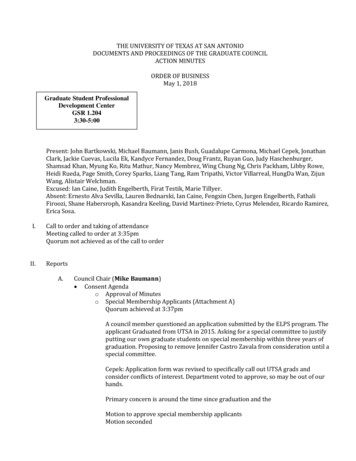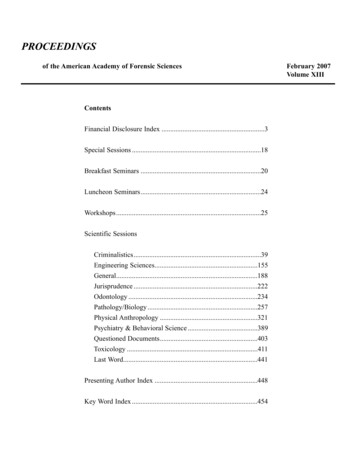
Transcription
ProceedingsFull-scale testing of a masonry building monitoredwith smart brick sensors†Antonella D’Alessandro1*, Andrea Meoni1, Enrique García-Macías2, Massimiliano Gioffrè1,Nicola Cavalagli1 and Filippo Ubertini1Department of Civil and Environmental Engineering, University of Perugia, Perugia 06125, Italy;antonella.dalessandro@unipg.it (A.D).; andrea.meoni@unipg.it (A.M.); massimiliano.gioffre@unipg.it (M.G.);nicola.cavalagli@unipg.it (N.C.); filippo.ubertini@unipg.it (F.U.)2 Department of Continuum Mechanics and Structural Analysis, School of Engineering, Universidad deSevilla, Sevilla 41004, Spain; egarcia28@us.es (E.G.M.)* Correspondence antonella.dalessandro@unipg.it; Tel.: 39-075-585-3910† Presented at the 5th International Electronic Conference on Sensors and Applications, 15-30 November 2018.1Received: date; Accepted: date; Published: dateAbstract: The seismic monitoring of masonry structures is especially challenging due to theirbrittle resistance behavior. A tailored sensing system could, in principle, help to detect and locatecracks and anticipate the risks of local and global collapses, allowing prompt interventions andensuring users’ safety. Unfortunately, off-the-shelf sensors do not meet the criteria that are neededfor this purpose, due to their durability issues, costs and extensive maintenance requirements. As apossible solution for earthquake-induced damage detection and localization in masonry structures,the authors have recently introduced the novel sensing technology of “smart bricks”, that are claybricks with self-sensing capabilities, whose electromechanical properties have been alreadycharacterized in previous work. The bricks are fabricated by doping traditional clay with conductivestainless steel microfibers, enhancing the electrical sensitivity of the material to strain. If placed atkey locations within the structure, this technology permits to detect and locate permanent changes indeformation under dead loading conditions, associated to a change in structural conditionsfollowing an earthquake. In this way, a quick post-earthquake assessment of the monitored structurecan be achieved, at lower costs and with lower maintenance requirements in comparison totraditional sensors. In this paper, the authors further investigate the electro-mechanical behavior ofsmart bricks, with a specific attention to the fabrication of the electrodes, and exemplify theirapplication for damage detection and localization in a full-scale shaking table test on a masonrybuilding specimen. Experimental results show that smart bricks’ outputs can effectively allow thedetection of local permanent changes in deformation following a progressive damage, as alsoconfirmed by a 3D finite element simulation carried out for validation purposes.Keywords: smart brick sensors; damage detection; structural health monitoring; strainsensitivity; masonry structures; seismic behavior1. IntroductionThe majority of historical buildings worldwide are made of stone or brick masonry and theircultural value makes their maintenance and preservation of pivotal importance for the community.Monitoring technologies can aid the preventive conservation activities by using sensor networks,deployed at critical locations within the building, to identify the behavioral conditions of thestructure and their variations caused by cracks or incipient damages due to the degradation of thematerials or critical natural events. In particular, masonry structures are quite vulnerable toearthquakes due to their brittle behavior which often results in sudden failures [1, 2]. A tailoredProceedings 2018, 2, x; doi: FOR PEER REVIEWwww.mdpi.com/journal/proceedings
Proceedings 2018, 2, x FOR PEER REVIEW2 of 6Structural Health Monitoring (SHM) can be useful to recognize such occurrence and increaseoccupants’ safety [3]. To this purposes, several researchers are working at developing low-invasiveand effective techniques for evaluating mechanical properties, as well as dynamic signatures, ofmasonry structures [4]. In order to contribute to this research, the Authors have recently developed aburned clay sensor, called smart brick, with strain-monitoring capabilities and conceived to beinserted within the masonry as a normal clay brick [5, 6]. The smart brick has a clay matrix dopedwith steel micro fillers which enhance the electrical capabilities of the material. Critical issues arise inthe correct quantification and dispersion of the inclusions, in the optimization of the measurementsetup, as well as in signal processing aimed at damage detection and localization. In this paper, theauthors further investigate the electro-mechanical behavior of smart bricks with respect to previouswork, with a specific attention to the fabrication of the electrodes, and exemplify their application fordamage detection and localization in a full-scale shaking table test on a masonry building specimen.Experimental results show that smart bricks’ outputs can effectively allow the detection of localpermanent changes in deformation following a progressive damage, as also confirmed by a 3D finiteelement simulation carried out for validation purposes.2. Structural Clay-based SensorsThe smart bricks used for the present research were prepared by mechanically mixing differentamounts of fillers – from 0.25% to 2% with respect of the whole weight - into the fresh clay (Fig. 1(a)).The fillers were stainless steel fibers, model R.STAT/S. The resulting composite was poured intoprismatic molds, initially sprinkled with sand and then dried (Figs. 1(b-c)). After a thermal cycle of12 hours up to at 900 C, the samples were instrumented with two different types of electrodes:copper plates or conductive resin with embedded copper strips [7] (Fig. 1(d)). The conductive resinwas obtained by adding graphite powder to Araldite 2020 in the percentage of 75% in weight. Thesmart bricks were prisms with dimensions of 50x50x70 mm3. It is key to note that the deployment ofthe electrodes is fundamentally different in the two configurations, as copper electrodes layhorizontally, while resin electrodes lay vertically. In the latter case, therefore, spuriousstrain-sensing effects at the contact interface with the electrodes due to the applied verticalcompression should be eliminated.Figure 1. Photographic sketch of the preparation procedure of the brick sensors with steelmicrofibers3. MethodsThree different types of tests were carried out to compare the electrical behavior of the smartbricks with different types of electrodes and to investigate their sensing capabilities: electrical testsfor investigating conductivity properties, electromechanical tests for the analysis of strain sensitivityand a full-scale test on a masonry small building to demonstrate the potential of the technology forin situ monitoring purposes.3.1. Electrical testsElectrical tests were carried out by applying a square wave with 20 V peak-to-peak by using aRIGOL DG1022 function generator. The function had a duty cycle of 50% and a frequency of 1Hz.Electrical measurements were recorded through a DAQ NI PXIe-1073 with a digital multimeter NIPXI-4071 at a sampling frequency of 10 Hz.
Proceedings 2018, 2, x FOR PEER REVIEW3 of 6Conductivity was achieved through the following equation, considering current measurementstaken at the point at 80% of the positive constant part of the current waveform signal: t lA V I t(1)where, V is the applied constant voltage (Vpp/2), It is the measured current intensity, A is the sectionof the sample, l the distance between the electrodes and t is the time of the measurement.Figure 2. Setup of the electrical and electromechanical tests: (a) data acquisition system; (b) a sampleduring the tests.Figure 3. Full-scale tests: (a) placement of the smart brick in the masonry; (b) setup for the electricalmeasurements; (c) picture of the tested building3.2. Electromechanical testsElectromechanical tests were conducted by using the same setup described in Section 3.1. Theloading-unloading cycles were applied using a press with a maximum load of 20 tons. Figure 2shows the electrical setup and a detailed view of a smart brick during the tests.3.3. Tests on full-scale masonry buildingsThe full-scale test was carried out on a masonry building of two floors, built at the ENEACasaccia Research Center (Fig. 3(c)), with a base of 290 x 340 cm and a height of 490 cm. Eight smartbricks were placed in the bottom parts of the four building’s façades (Fig. 3(a)). The masonrystructure was subjected to increasing seismic inputs (including white noise inputs (WNs) and
Proceedings 2018, 2, x FOR PEER REVIEW4 of 6earthquakes (Es)) through a shaking table. The electrical measurements were recorded after eachearthquake input (Fig. 3(b)).The changes in volumetric strain, for a step, s, of the seismic sequence and for the i-th smartbrick, were evaluated with: is 1 Ris Ri0GFi Ri0(2)where Ris is the electrical resistance measured after the s-step of the seismic sequence, Ri0 𝑅𝑖0 isthe value of the electrical resistance for the undamaged condition and 𝐺𝐹𝑖 𝑖𝑠 the estimated gaugefactor.4. Tests and Results4.1. Electrical testsFigure 4 shows the comparison of the electrical conductivity measured on the smart bricks withdifferent types of electrodes. The results highlight a consistent behavior, with a percolation liketrend, also demonstrating, at the same time, that resin electrodes result in an overall higherconductivity conceivably owing to a reduction of the contact electrical resistance.Figure 4. Comparison of electrical tests on samples with plate and resin electrodes.4.2. Electromechanical testsFigure 5 shows an example of electromechanical outputs of smart bricks with different types ofelectrodes and a comparison against the outputs of traditional strain gauges applied on the sensors.A clear correlation between actual strain and electrical outputs of smart bricks can be observed,where it has to be noted that the brick with resin electrodes provides a more linear strain sensingbehavior compared to the one with copper plate electrodes. In this case the lower strain sensitivity isdue to the different configuration of the electrodes (cfr. Section 2), while the improved quality of thesignal is conceivably due to the elimination of spurious effects at the contact interface.Table 1 summarizes the electrical performance of the smart bricks with different amounts offillers and instrumented with copper plate electrodes. Although resin electrodes are betterperforming, in this exploratory study smart bricks with copper plate electrodes were used for thefull scale experiment in order to maximize strain sensitivity.4.3. Tests on full-scale masonry buildingsExperimental results obtained at increasing levels of the white noise and seismic loads werecompared to a numerical macro-mechanical FE analysis, using a model characterized by a mesh sizeof 50 mm. Further details on the numerical simulations are omitted for the sake of brevity but areprovided in the slide presentation of the paper.
Proceedings 2018, 2, x FOR PEER REVIEW5 of 6Figure 5. Electromechanical tests of the smart bricks with 0.75% of stainless steel microfibers with: (a)copper plate electrodes; (b) resin electrodes.Table 1. Initial resistance R0, gauge factors GFs and Sensitivity S of smart brick with copper plateelectrodes and different amounts of fillers.SampleR0 [Ω]GFS [Ω]0.00%6,34E 071811,15E 100.25%3,59E 074961,78E 100.50%2,44E 072195,33E 090.75%5,19E 064642,41E 091.50%2,48E 0610282,55E 092.00%3,40E 057952,71E 08Figure 6. Comparison between normalized changes in volumetric strain from the experimental and numericalmeasurements for sensors placed on façade 4.
Proceedings 2018, 2, x FOR PEER REVIEW6 of 6Figure 6 shows an example of comparison between experimental and numerical outputs interms of volumetric strain under dead load after each step of the experimental sequence: the resultsappear to be quite correlated and confirm that the smart bricks are capable to provide the trend ofchange of volumetric strain under dead loads due to changes in structural conditions caused byprogressive damage.5. ConclusionsThis paper has presented the results of electrical, electromechanical and full-scale investigationson novel smart bricks doped with stainless-steel microfibers. Different types of electrodes andvarious amounts of fillers were analyzed in order to assess the self-sensing behavior of the smartsensors. The results showed that vertical resin electrodes are able to reduce the contact resistanceaffecting electrical measurements and are promising for further application. The smart brickspossess interesting self-monitoring capabilities, demonstrated by their high gauge factors. Full-scaleresults show that such smart bricks can identify permanent changes in strain under dead loadsassociated to a progressive damage: this result is particularly valuable for quick assessments of astructural integrity of masonry constructions after important events as earthquakes.Author Contributions: investigation and data analysis, A.D and A.M.; modeling, A.M., N.C. and E.G.M.;writing—original draft preparation, A.D.; writing—review and editing, A.D. and F.U.; visualization, A.D. andA.M.; supervision, F.U., funding acquisition, F.U. and M.G.Funding: This research was funded by Italian Ministry of Education, University and Research (MIUR) throughthe funded Project of Relevant National Interest “SMART-BRICK: Novel strain-sensing nanocomposite claybrick enabling self-monitoring masonry structures (protocol no. 2015MS5L27). The paper was also supportedby "Fondazione Cassa di Risparmio di Perugia", research project "Casa Sicura", Grant Number 2017.0233.021.Acknowledgements: The Authors acknowledge Fornaci Briziarelli Marsciano Spa, who provided technicalsupport for the preparation of the smart bricks and for the building of the masonry specimens.Conflicts of Interest: The authors declare no conflict of interest.References1.2.3.4.5.6.7.Formisano A., Vaiano G., Fabbrocino F., Milani G. Seismic vulnerability of Italian masonry churches: Thecase of the Nativity of Blessed Virgin Mary in Stellata of Bondeno. Journal of Building Engineering 2018; 20:179–200.De Lorenzis L., DeJong M., Ochsendorf J. Failure of masonry arches under impulse base motion. EarthqEng Struct D 2007; 36(14): 2119–2136.Saisi A., Gentile C., Guidobaldi M., Xu M. Dynamic monitoring and seismic response of a historic masonrytower. Key Eng Mater 2014; 628Carpinteri A., Lacidogna G. Damage monitoring of an historical masonry building by the acousticemission technique. Mater Struct 2006; 39(2): 161–167.D’Alessandro A, Meoni A, Ubertini F. Stainless Steel Microfibers for Strain-Sensing Smart Clay Bricks.Journal of Sensors 2018; 2018(7431823): 8. https://doi.org/10.1155/2018/7431823.Downey A., D’Alessandro A., Ubertini F., Laflamme S., Geiger R. Biphasic DC measurement approach forenhanced measurement stability and multi-channel sampling of self-sensing multi-functional structuralmaterials doped with carbon-based additives. Smart Mater Struct 2017; 26(065008): 6.Cacciotti R., Jaroslav Valach J., Benjamin Wolf B., Innovative and easy-to-implement moisture monitoringsystem for brick units. Constr Build Mater 2018 186 598–614 2018 by the authors. Submitted for possible open access publication under the termsand conditions of the Creative Commons Attribution (CC BY) /).
Electrical measurements were recorded through a DAQ NI PXIe-1073 with a digital multimeter NI PXI-4071 at a sampling frequency of 10 Hz. Proceedings 2018, 2, x FOR PEER REVIEW 3 of 6 Conductivity was achieved through


